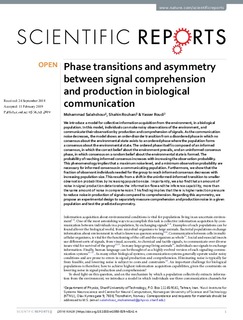| dc.contributor.author | Salahshour, Mohammad | |
| dc.contributor.author | Rouhani, Shahin | |
| dc.contributor.author | Roudi, Yasser | |
| dc.date.accessioned | 2020-02-18T08:40:59Z | |
| dc.date.available | 2020-02-18T08:40:59Z | |
| dc.date.created | 2019-10-22T09:42:49Z | |
| dc.date.issued | 2019 | |
| dc.identifier.issn | 2045-2322 | |
| dc.identifier.uri | http://hdl.handle.net/11250/2642148 | |
| dc.description.abstract | We introduce a model for collective information acquisition from the environment, in a biological population. In this model, individuals can make noisy observations of the environment, and communicate their observation by production and comprehension of signals. As the communication noise decreases, the model shows an order-disorder transition from a disordered phase in which no consensus about the environmental state exists to an ordered phase where the population forms a consensus about the environmental state. The ordered phase itself is composed of an informed consensus, in which the correct belief about the environment prevails, and an uninformed consensus phase, in which consensus on a random belief about the environmental state is formed. The probability of reaching informed consensus increases with increasing the observation probability. This phenomenology implies that a maximum noise level, and a minimum observation probability are necessary for informed consensus in a communicating population. Furthermore, we show that the fraction of observant individuals needed for the group to reach informed consensus decreases with increasing population size. This results from a shift in the uninformed-informed transition to smaller observation probabilities by increasing population size. Importantly, we also find that an amount of noise in signal production deteriorates the information flow and the inference capability, more than the same amount of noise in comprehension. This finding implies that there is higher selection pressure to reduce noise in production of signals compared to comprehension. Regarding this asymmetry, we propose an experimental design to separately measure comprehension and production noise in a given population and test the predicted asymmetry. | nb_NO |
| dc.language.iso | eng | nb_NO |
| dc.publisher | Nature Research | nb_NO |
| dc.rights | Navngivelse 4.0 Internasjonal | * |
| dc.rights.uri | http://creativecommons.org/licenses/by/4.0/deed.no | * |
| dc.title | Phase transitions and asymmetry between signal comprehension and production in biological communication | nb_NO |
| dc.type | Journal article | nb_NO |
| dc.type | Peer reviewed | nb_NO |
| dc.description.version | publishedVersion | nb_NO |
| dc.source.volume | 9 | nb_NO |
| dc.source.journal | Scientific Reports | nb_NO |
| dc.source.issue | 1 | nb_NO |
| dc.identifier.doi | 10.1038/s41598-019-40141-4 | |
| dc.identifier.cristin | 1739403 | |
| dc.relation.project | Norges forskningsråd: 223262 | nb_NO |
| dc.description.localcode | © The Author(s) 2019. Open Access This article is licensed under a Creative Commons Attribution 4.0 International License, which permits use, sharing, adaptation, distribution and reproduction in any medium or format, as long as you give appropriate credit to the original author(s) and the source, provide a link to the Cre-ative Commons license, and indicate if changes were made. The images or other third party material in this article are included in the article’s Creative Commons license, unless indicated otherwise in a credit line to the material. If material is not included in the article’s Creative Commons license and your intended use is not per-mitted by statutory regulation or exceeds the permitted use, you will need to obtain permission directly from the copyright holder. To view a copy of this license, visit http://creativecommons.org/licenses/by/4.0/. | nb_NO |
| cristin.unitcode | 194,65,60,0 | |
| cristin.unitname | Kavliinstitutt for nevrovitenskap | |
| cristin.ispublished | true | |
| cristin.fulltext | original | |
| cristin.qualitycode | 1 | |

